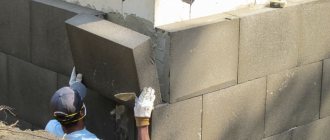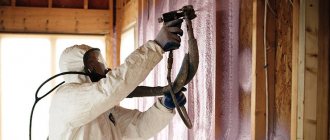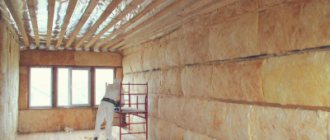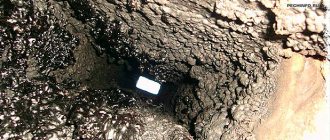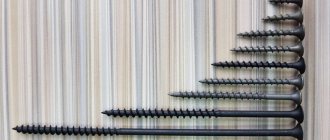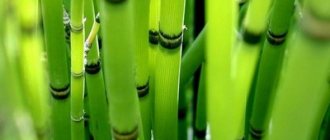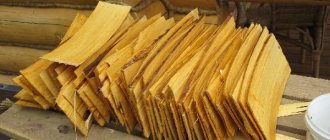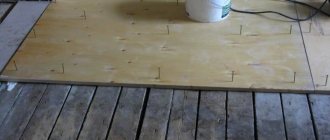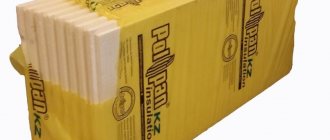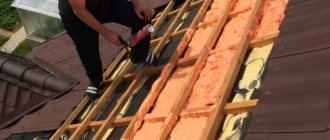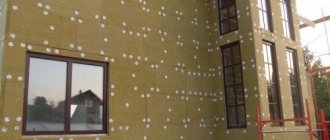Features of the material
This material is a foamed polymer, a type of polystyrene foam. This is a special plastic consisting of many gas-filled cells. It turns out that only 2% of polyurethane foam is a solid material, and the rest is gas. Typically the cells are filled with air.
This material consists of two polymers: polyisocyanate and polyol. They join together and foam. The process is accompanied by the release of a large amount of gas. Within a few seconds it freezes.
In this case, an elastic elastic material of varying degrees of rigidity is formed. The scope of its application depends on this. In addition to being used as thermal insulation, polyurethane foam is common as a filler for mattresses and upholstered furniture.
Features of polyurethane
The important characteristics of polyurethane foam, due to which it is so widespread, include:
- elasticity, flexibility and resilience are explained by the fact that more than 90% of its volume is occupied by gas bubbles;
- durability and wear resistance;
- several varieties according to the degree of hardness;
- Various additives provide additional protection from moisture, high temperature, and sound insulation.
But the main property is the low thermal conductivity of polyurethane foam.
Important! It protects against cold penetration into the room better than other insulating materials and maintains normal temperature.
*
Application
The universal material is used in almost all areas of industry:
- Automotive: car seat filler, vehicle interior soundproofing.
- Mechanical engineering: cold insulator in household and commercial refrigerators, large refrigeration chambers, transport refrigeration equipment, medical installations.
- Transport: heat insulators for main pipelines, insulators for low-temperature pipelines in the chemical industry.
- Shoe industry: production of instep supports and other shoe elements.
- Furniture: soft polyurethane foams are used as filler and cushioning material for upholstered furniture.
- Lightweight: PU foam filler is used for sewing soft toys, mattresses, pillows, and mannequins.
- Construction: sandwich panels, acoustic insulation, waterproofing, thermal insulation raw materials for residential and industrial premises, warehouses, garages, hangars. To seal cracks and spaces between loosely fitting parts, urethane wood glue is used.
PPU for furniture
The chemical compound is a technological analogue of springs. It is simpler and cheaper to produce, and in terms of performance characteristics it does not lag behind, and in many cases even surpasses, springs. Polyurethane foam for furniture is available in different forms:
- Sandwich or block. This is a large “brick”. During the production process, furniture factory workers cut it into layers of different shapes and thicknesses. Then experts combine hard and soft layers, folding them into seats and backrests.
- Cast. Produced at a furniture factory. The liquid mixture is filled into a shaped blank, a chemical reaction occurs in it, and the polyurethane foam hardens under pressure. The final product takes on the exact size and shape of the sofa cushion or seat. Pros - no scraps, cons - a “crust” forms on the surface of the block, which does not allow air to pass through well. The price of sofas with molded polyurethane foam is higher than that of models with block lining.
Soft polyurethane foam with a density of 30-40 kg/m3 is used for furniture. The higher the indicator, the tougher and more durable the product. Low density polyurethane foam (up to 25 kg/m3) is suitable for decorative pillows. There are several types of materials with a polyurethane foam base: lokfoam, vibrofoam, Fomex (USA), moltoprene (Germany), allofoam (Canada). Their characteristics are similar to domestic polyurethane foam.
Compounds with a memory effect (memoform, memorix) deserve special attention. Thanks to special additives, the material becomes highly elastic. It knows how to maintain the shape of the person sitting and perfectly adapts to the curves of the body. When a person rises, the memorix quickly straightens. Polyurethane memory foam was originally developed for NASA, but then became popular in light industry.
The manufacturer promises a comfortable sleep, because Memorix gently envelops the body without squeezing the blood vessels. Highly elastic polyurethane foam also has disadvantages, and significant ones. After unpacking, customers feel a toxic odor that does not always disappear even after a week. There is no question of environmental friendliness and health safety, because after examination, a sample of Memorix was found to contain toxins that cause allergies, asthma, eye irritation, and headaches. Hydrocarbons emit a bitter-sweet odor and affect the nervous and immune systems.
In Western countries with enhanced environmental safety control, Memorix does not contain hazardous chemical components. Sanitary standards in the CIS countries are not so strict. Some people are ready to buy very expensive Memoryx pillows and mattresses and endure the unpleasant aroma, because after sleeping on them, back and neck pain goes away. There are also rave reviews about Memorix online - buyers of a quality product are very satisfied with their purchase.
Polyurethane foam thermal insulation
A liquid mixture is used to insulate structures of any type. It is applied by spraying. Using special equipment, polyurethane foam is sprayed onto the wall, foundation, roof or various containers, which instantly increases in volume and fills cavities and cracks. The composition hardens after 5-10 minutes. The monolithic porous “coat” firmly adheres to the surface, has no seams or joints, and therefore reliably protects against heat leakage or penetration (relevant in the summer when the air conditioning system is running).
The number of closed cells is more than 92%, and for the best samples it is 97-98%. Thermal conductivity reaches 0.019-0.035 W/m°C. This indicator is the lowest among other insulation materials - polystyrene foam, polystyrene foam, polyethylene foam. Thermal insulating polyurethane foam has good moisture resistance. To reduce hygroscopicity, additives are added to the composition. Castor oil reduces hydrophilicity by 4 times. Polyurethane foam is resistant to basic chemical compounds: it does not dissolve in gasoline or diesel fuel. The service life of the “fur coat” is 20-30 years.
For insulation, ready-made thermal insulating polyurethane foam parts are also used: blocks, panels, semi-cylinders (pipe shells), but in terms of demand they are inferior to liquid polyurethane foam. The latter is applied not only to open surfaces, but also serves as an intermediate layer in sandwich panels. The flammability class of the substance is G2 and G3. The compound is not an active source of combustion; it will immediately go out if the fire is removed from it.
- Vitamin C tablets for adults and children. Instructions for use of vitamin C and daily dosage
- How to find a lost phone. How to determine the location of a mobile phone via satellite, Internet or IMEI
- White discharge in women
Description
In terms of its technical characteristics, polyurethane foam surpasses all other heat-insulating materials. It is considered better than such common insulation materials as mineral wool or expanded polystyrene. Polyurethane foam does not pose any danger to human health, so it is often used indoors.
Insulation with polyurethane
Thermal conductivity
This material is especially valued for its heat-insulating properties. It ensures maintenance of a comfortable temperature both during winter frosts and during summer heat. Polyurethane foam has a very low thermal conductivity coefficient. And the lower it is, the less material is required for insulation and the better it retains heat.
Noise absorption
The high density of polyurethane foam provides its sound-absorbing properties. When using it, noise from the street will not pass into the room. Moreover, sound insulation is higher than that of other common insulation materials.
Chemical resistance
An important property of this material is also its resistance to various chemicals. It is not destroyed by gasoline, most acids, alcohols, and oils. It also does not absorb these harmful substances, making it safe for residential use. In addition, this resistance has another useful property: polyurethane foam protects building materials from rotting and corrosion.
Insulation process
*
Moisture absorption
The resistance of this material to moisture depends on the density. The denser the polyurethane foam, the less its water absorption. Usually it accumulates moisture no more than 3% of its volume. This amount can be further reduced thanks to special water-repellent impregnations. As a result, this insulating material does not allow moisture from the atmosphere to enter the room. It also hardly absorbs steam.
Fire resistance and combustibility
Polyurethane foam itself is a non-flammable material. It lights up poorly, goes out quickly, does not smoke, and does not emit harmful substances. During construction, the ability of polyurethane foam to burn is further reduced with the help of special additives. The result is the most fireproof material of all insulation materials.
Density
Depending on the type, the density of polyurethane foam may vary. But in all cases it is a very light and elastic material. On average, the density is 40-60 kg/m3. But according to this parameter, two varieties are distinguished:
- Open-cell polyurethane foam is very elastic, soft, not very dense, density no more than 20 kg/m3;
- Closed cell polyurethane foam is more rigid and dense, its density can reach 150 kg/m3.
Density of polyurethane
Rigidity
The hardness of this material can also vary. It depends on the concentration of the main substances and the production method. Soft elastic polyurethane foam is most often used as a filler for upholstered furniture and mattresses.
Important! A more rigid type is more suitable for insulating rooms and communications.
*
Durability
The advantages of polyurethane foam also include service life. It does not lose its properties for 40-50 years. Therefore, it is considered the most durable insulation.
Eco-safety
This material is often used both outdoors and indoors. Therefore, many people are interested in whether polyurethane foam will cause any harm to health. Research has proven that this is the safest insulation. It does not emit toxic substances or harmful fumes, does not accumulate moisture and chemicals, and is resistant to the formation of bacteria, fungi, and mold.
The environmental friendliness of this material allows it to be used even in children's rooms, for the production of toys and bedding. And due to the fact that it does not emit toxic compounds, it is used for insulation in refrigeration equipment.
Eco-safety of polyurethane
Insulation materials
0 votes
+
Vote for!
—
Vote against!
Polyurethane foam is in great demand in the building materials market. It is an excellent insulation material for various types of structures. We will talk further about the application features, advantages and disadvantages of polyurethane foam.
Table of contents:
- Polyurethane foam material - general information and manufacturing technology
- Polyurethane insulation reviews and methods
- Polyurethane foam insulation: advantages and disadvantages
- Polyurethane foam characteristics of technical composition
- Polyurethane foam thermal insulation technology
Polyurethane foam material - general information and manufacturing technology
Polyurethane foam has the form of a foamed plastic material with a homogeneous structure in the form of inclusions of air bubbles. They are the main part of it. Polyurethane foam has the lowest thermal conductivity and good moisture-repellent properties.
In addition, this material is considered environmentally friendly and harmless to human health.
There are several types of polyurethane foam according to its structure:
- rigid polyurethane foam;
- elastic type;
- integral type.
The first option is characterized by high density; despite its hardness, it is light in weight. Rigid polyurethane is an excellent sound and heat insulator.
The elastic version of polyurethane is similar to foam rubber, although, in comparison, it is stronger and more durable. Its use is associated with the manufacture of furniture; due to its harmlessness, this material is widely used in the medical industry.
The integral version of polyurethane foam has a monolithic structure and the densest consistency. Its use is associated with the automotive industry.
The first scientist to discover polyurethane was Otto Bayer. He planned to invent a material that would completely replace rubber.
In the modern construction industry, polyurethane foam is an indispensable thermal insulation material. This is due to its light weight, moisture resistance, and minimal thermal conductivity coefficient.
There is an option of spraying polyurethane foam onto the surface, thus achieving a seamless structure with excellent thermal insulation characteristics.
It is these characteristics that make polyurethane foam popular as a heat insulator. The rigid version of polyurethane foam is intended for the manufacture of heat-insulating panels that are easy to install and resistant to heat loss. A fairly popular option is the use of sandwich panels, which use polyurethane foam as a thermal insulation layer. With their help, various types of premises and buildings are erected in the shortest possible time. In addition, clinker tiles also consist of a heat-insulating layer, for the manufacture of which polyurethane foam is used, and a decorative outer layer made of ceramics.
The production of polyurethane foam is based on mixing various components, such as isocyanate and polyol. During this procedure, the material foams and increases in volume. Next, it hardens.
During the production of polyurethane foam, a certain technology must be followed, which involves maintaining a certain air temperature when mixing the components. In addition, all components must be thoroughly mixed.
If the air temperature is low enough, then polyurethane foam will require a large amount of raw materials for its production; the amount of defects after completion of the manufacturing process will increase several times than at the optimal temperature.
High-quality mixing of all components allows you to obtain polyurethane foam of a homogeneous structure, in which there are no air cavities or seals.
Polyurethane insulation reviews and methods
There are two ways to make polyurethane foam:
- using spraying;
- filling.
The first option has more favorable conditions, since it does not require additional installation of building structures. Spraying polyurethane foam helps to thermally insulate residential, public and industrial premises, pipelines, tanks, etc.
Polyurethane foam easily fits on all kinds of surfaces, even oily ones. Due to the fact that the thermal conductivity of this material is quite low, it is applied in a small layer and allows you to save on the amount of material. In addition, the spraying method allows you to obtain a complete, seamless structure that prevents heat transmission.
To install polyurethane foam using this method, special equipment is used, which mixes the finished components among themselves and delivers them under pressure to the surface required for insulation.
Filling with polyurethane foam involves mixing the components together and delivering them to the surface without exposure to air. In this case, material consumption increases. Using this method, shells are made that are installed on pipelines that require thermal insulation. Also, with the help of this equipment it is possible to produce polyurethane slabs or sandwich panels. The material is poured into a special kind of mold, in which it hardens and acquires the desired size.
They also produce polyurethane products that decorate the interior or exterior. In order to save on installing insulation, you should pour polyurethane foam into the space between the walls. If we compare brick with polyurethane foam, then a layer of insulation 1 cm thick is equal to brickwork, the thickness of which is 25 cm.
Therefore, the use of polyurethane foam in the process of building a house allows you to get a building with excellent thermal insulation characteristics at an affordable cost. Please note that when using the method of pouring polyurethane foam, in the process of manufacturing various types of products, you should use a special kind of lubricant that is applied to the surface of the mold to avoid adhesion of the material to its surface.
Polyurethane foam insulation: advantages and disadvantages
Regarding the insulation of walls with polyurethane foam, we highlight the following advantages:
1. High level of adhesion to almost any type of surface, oil, wood, glass, brick, metal. In addition, the shape and curvature of the surface does not in any way affect the quality of insulation. Before applying polyurethane foam, the surface does not require preparation or additional treatment with various kinds of means.
2. Minimum material consumption is ensured by using the spraying method. In addition, installation of polyurethane foam is quite simple and is carried out directly on the construction site.
3. Polyurethane foam is a fairly lightweight material, so it does not load the overall structure of the building, especially important for thermal insulation of roofs.
4. When using polyurethane foam as insulation for walls, in addition to low thermal conductivity, they acquire additional strength.
5. Polyurethane foam is resistant to changes in temperature; the temperature range for it is from -150 to +150 degrees.
6. The service life of polyurethane foam is at least 20 years.
7. The procedure for applying insulation involves obtaining a homogeneous mass in which there are no seams or cold bridges.
8. To install polyurethane foam as insulation, it is not necessary to install fasteners or special structures.
Despite this, polyurethane foam has certain disadvantages, including:
1. The rigid type of polyurethane foam has a rather low vapor permeability, which negatively affects the provision of a comfortable atmosphere in the room. If you apply polyurethane foam to the attic, its walls will be susceptible to dampness, as well as the spread of mold and mildew.
2. Ultraviolet radiation that hits the polyurethane foam coating worsens its thermal insulation characteristics.
3. Thermal insulation with polyurethane foam using the spraying method implies a low level of fire safety. Since the coating becomes more flammable.
4. Installing foam in the space between walls, if they are made of fragile materials, leads to deformation, since polyurethane foam expands and creates a certain pressure.
Polyurethane foam characteristics of technical composition
It is the rigid type of polyurethane foam that is used in the construction industry. Since it has good thermal insulation characteristics, vapor resistance, water resistance, resistance to corrosion, aggressive environments and radiation. In addition, it is characterized by high strength, resistance to changes in temperature and various other external influences. We invite you to familiarize yourself with the technical features of insulation called polyurethane foam:
1. Thermal conductivity properties.
This factor depends on the size and number of empty cells that are in the polyurethane foam. Although, if we compare this material with polystyrene foam, mineral wool or other insulation materials, polyurethane foam still wins.
2. Sound absorption.
This property depends primarily on such parameters as elasticity, vapor permeability, insulation thickness, etc. In polyurethane foam, the level of sound insulation is determined by its density and rigidity; the higher it is, the better the material does not transmit sounds.
3. Resistance to chemical compounds.
Polyurethane foam is more resistant to aggressive environments than, for example, polystyrene foam. It has excellent resistance to gasoline, various types of oils, alcohol, acids and plasticizers.
When polyurethane foam is applied to a steel surface, protection is formed in the form of two films, which are located inside and outside the material. They do not allow moisture and other chemicals to reach the steel surface, thereby preventing its corrosion.
4. Moisture absorption level.
This material has a very low level of moisture absorption. This factor is influenced by the number of different components included in the polyurethane foam. The denser the structure of the insulation, the less moisture it is able to pass through or absorb. The presence of castor oil in the material increases its moisture resistance several times.
5. Fire safety.
It has fairly low flammability. To increase fire resistance during the preparation of the material, special additives are introduced into its composition or chemical components are changed. To implement the second option, a considerable amount of money will be required, so the first option is more popular, according to which fillers in the form of phosphorus compounds or halogens are added to the ingredients for the production of polyurethane foam.
6. Characteristics of material density.
This property completely depends on the technology for preparing and applying polyurethane foam to the surface. The choice of density depends on the specific conditions of use of the substance. For example, a low-density material is excellent for making furniture, a medium-density polyurethane foam allows for insulation of buildings, and an extremely dense substance is used for car interior trim.
7. Duration of operation.
The minimum period of use of this material, subject to the technology of its manufacture, application and operation, is twenty years.
8. Polyurethane foam is not harmful to health or environmental safety.
After 15 seconds, after applying the material to the surface and hardening, it does not pose any harm to humans. When the material is heated to a temperature of more than 450 degrees, it begins to release carbon dioxide and carbon monoxide.
Polyurethane foam thermal insulation technology
In the process of insulating various types of surfaces, rigid and semi-rigid polyurethane foam is used. The first option has a closed structure and is relevant when insulating rigid structures, concrete or brick composition. The second version of this insulation is used when performing thermal insulation of frame houses, plasterboard structures, plywood or wooden buildings.
The insulation, which has a closed structure, has almost zero moisture absorption and excellent sound insulation characteristics.
The interior of the room is insulated using spraying, since as a result, a dew point begins to form and the walls freeze. But by insulating the external areas of the building, it is possible to achieve not only good thermal insulation, but also does not require installing vapor and sound insulation. In addition, the usable area of the premises remains the same, and the walls receive excellent protection from external influences.
Brick or frame walls are insulated using a device that supplies material under pressure. Within a few tens of seconds, polyurethane foam transforms from liquid foam into a solid state. After the foam has polymerized, the excess is cut off and plaster is applied to the surface or drywall is installed.
When foam is applied externally, vinyl siding or facing bricks are installed. It is possible to install hanging panels or even silicate or acrylic based paints.
The best protection for polyurethane foam is polyurea, which can last as an exterior finish for more than 45 years, although its cost is too high.
To ensure good adhesion of the foam and coating, it should first be cleaned of dust. After applying the insulation, it is coated with a primer.
It is possible to use ready-made polyurethane foam boards. They vary in terms of density, thickness and size. Since purchasing expensive equipment for applying polyurethane foam is not always relevant, this option becomes more acceptable.
The slabs should be mounted on a dry, pre-leveled surface that has previously been cleaned of dust. The quality of insulation depends on the evenness of the wall. To fix the slabs, adhesive mastic is used; for additional fastening, special dowels with a wide head are used.
To eliminate non-joints or cracks, polyurethane foam having a similar composition is used. Therefore, the surface becomes sealed and monolithic.
Is polyurethane foam harmful to health?
This question interests many. After all, insulation is most often applied from the inside of the walls. And since it is a polymer substance produced through a chemical reaction, people are afraid that it will release toxic substances.
Indeed, while liquid polyurethane foam is sprayed onto walls, its contact with the skin or inhalation can be dangerous. Therefore, it is recommended to carry out all work wearing a respirator and protective clothing.
But after hardening, polyurethane foam no longer causes harm. And it dries in 20 seconds, so the finished layer of heat-insulating material is absolutely safe.
Sputtering process
Kinds
Polyurethane foam differs in density, rigidity, and composition. There are two varieties: closed cell or open cell. The first one is denser and more durable, has low thermal conductivity, so it is more often used for thermal insulation.
The second type consists of open cells filled with gas. The structure of this polyurethane foam resembles a sponge; it is softer and more elastic. Therefore, it is more often used as a filler.
Highly elastic polyurethane foam is also produced. It is called artificial latex or memory foam. Due to the characteristics of the cells - they are different in size and randomly located - this material is very elastic, easily changes shape when pressed, but also quickly recovers. It is used for the production of orthopedic mattresses, car seats, and furniture.
PPU is also distinguished by shape. It comes in sheets or blocks that can be cut. But in construction, the liquid form of this material is most often used. It is sprayed onto different surfaces, quickly sticking to them, and after 20 seconds it hardens. This is a very convenient and simple way of thermal insulation.
Type of polyurethane foam
*
Basic properties of polyurethane foam
Most often, a rigid type of polyurethane foam is used in construction, so it is necessary to understand the characteristics of polyurethane foam specified in GOST:
- Thermal insulation. The material is used for insulation because it has ideal thermal conductivity, which can fluctuate between 0.019 and 0.035 W/(m*K). In this regard, polyurethane foam is superior to expanded clay gravel, mineral wool and gas glass.
- Noise absorption. Since the level of noise absorption depends not only on the sound vibrations themselves and their volume, but also on the properties of the material, an elastic, soft and well-permeable material is required. Through experiments, it was found that rigid polyurethane foam is a poor sound insulator; semi-elastic polyurethane foam was recognized as the best material for such purposes.
We advise you to study - Do-it-yourself brick barbecue oven: drawings and order
- Water resistance. The amount of water that polyurethane foam can absorb depends on its hardness. The softer the material, the more it absorbs moisture. Hard polyurethane foam absorbs from one to three percent of the original volume of material per day, which is one of the lowest rates. In addition, during construction, substances are often added to polyurethane foam to increase its waterproofing properties. There is no point in talking about the water resistance of foam rubber, since it is actively used in the production of sponges for washing and absorbs huge amounts of water.
- Flammability. PPU, according to GOST, is divided into self-extinguishing (S), low-flammable (TV) and low-flammable (TC). This classification indicates that there is practically no possibility of such a material catching fire; moreover, the ease of production of polyurethane foam allows you to add the necessary substances to it that increase fire resistance. Sometimes, to improve the quality of polyurethane foam, its formula is changed, but this method is expensive. In rooms with a high risk of fire, a method is often used in which a thin layer of fire-resistant material is applied to the main layer of polyurethane foam.
- Exposure to other chemicals. The stability of polyurethane foam is so high that if you apply it to metal, it will not rust. The material is resistant even to acids, not to mention gasoline, solvents and caustic vapors. Such properties of polyurethane foam allow it to be actively used as a protective layer on necessary surfaces. PUF dissolves only in concentrated sulfuric or nitric acid; when exposed to hydrochloric acid, alcohol, acetone, ethyl acetate and styrene, it swells.
- Density. There is no point in talking about a specific density indicator, since using different production methods produces different types of polyurethane foam with completely different densities. This is a big plus, since during construction or production several types of polyurethane foam may be required at once, differing in density.
- Life time. Since the material began to be actively used not so long ago, but now experts claim that the service life of polyurethane foam, according to GOST, is at least 20 years. In fact, the figure may be higher, since polyurethane foam was actively used in the construction of buildings in Europe in the seventies, and after dismantling these old houses it turned out that the material had not lost its properties at all and remained unchanged.
Areas of application
Polyurethane foam is widely used in construction as a heat-insulating material. It can be used to insulate brick, concrete or wooden structures. It is used to treat foundations, roofs, and exterior walls of houses. In addition, due to the beneficial properties of this material, it is also in demand in other areas:
- in industry and instrument making;
- in cars, airplanes, ships;
- for insulation of pipelines, heating networks.
Elastic varieties of polyurethane foam are widely used in the production of furniture and bedding. Mattresses and sofa fillings made of polyurethane foam are popular due to its ability to retain shape, environmental friendliness, and durability.
Areas of application of polyurethane foam
Literature
- Saunders D., Frisch K. Chemistry of polyurethanes: Transl. from English M.: Khimiya, 1968;
- Lyubartovich S. A., Morozov Yu. L., Tretyakov O. B. Reaction molding of polyurethanes. M.: Khimiya, 1990. 288 p.;
Standards and norms
- Decree of the Moscow Government No. 91-PP - standards for use in thermal insulation of pipes and heating mains;
- Thermal insulation of enclosing structures of buildings and structures - STO 00044807-001-2006;
- Thermal insulation of pipelines with casting polyurethane foam VSN 462-85 (Approved by the USSR Ministry of Montazhspetsstroy);
- Sanitary rules for the production of synthetic and polymeric materials N 4783-88
What is made from polyurethane foam and where can it be used in the home?
In the workshops, sandwich panels are made from polyurethane foam from which you can build a house. An alternative technology is to spray insulation directly onto a large area of the walls and roof of the house, then line the inside with environmentally friendly panels.
Polyurethane foam shells for pipes are reliable thermal insulation that is resistant to water. And pipelines and containers, for example a water storage tank, when installed in the attic, can be insulated by spraying while insulating the entire house. Learn more about water storage tanks in the house
We can find polyurethane foam in doors, these are the most expensive products, as well as in home appliances - in water heaters and refrigerators. Compact designs and long-term temperature retention are all due to this insulation. It is also used to make decor and stucco not only inside buildings but also outside. And also a variety of objects, for example, a saddle for a motorcycle, or used inside a mattress...
What durability, changes over time
It is believed that polyurethane foam will serve without problems for at least 30 years. Let's consider how negative factors influence.
- Exposure to freezing cycles in combination with water does not have a visible destructive effect on this material. No cracks or breaks were found inside the material at any depth.
- Ultraviolet radiation has a detrimental effect on the surface layer. But at a depth of 1 centimeter over a period of 60 years, no changes were detected, even with very intense radiation.
- The thermal conductivity coefficient increases by no more than 30% over 100 years. In fact, the material retains its calculated thermal insulation values throughout its service life.
- Vibration and mechanical loads (without separation or shear) did not lead to discontinuities and crumbling of the material within the specified service life.
We advise you to study - Do-it-yourself wardrobe-bed (19 photos)
As you can see, the material is resistant to external influences that can usually affect the insulation layer of insulation materials. The influence of ultraviolet radiation must be reduced by using reliable paint and varnish coatings, constructing façade fencing, etc.
Review of manufacturers
In order for the insulation of the house to go without problems, and for the polyurethane foam to be of high quality, you need to purchase it from well-known manufacturers. There are several most popular companies:
- SYNTHESIA ESPANOLA SA produces different types of polyurethane foam, the materials are of high quality and ease of use;
- Ecotermix produces various thermal insulation systems, sprayed types of polyurethane foam;
- Demilec produces environmentally friendly thermal insulation based on polyurethane foam;
- Bayer is the world's leading chemicals manufacturer.
Advantages and disadvantages
Polyurethane foam is often used for thermal insulation, sealing cracks and seams. Due to its lightness, low thermal conductivity, and durability, it is very popular. But before using it, you need to know everything about its pros and cons. The disadvantages include its destruction under the influence of sunlight or high temperature. In addition, many do not like the complexity of its application and the harmfulness of such work.
But this material has more advantages:
- the most important advantage is the durability of polyurethane foam;
- it is lightweight, so it is suitable for insulating attics and roofs;
- applies quickly, hardens in 20 seconds;
- resistant to temperature changes from +2000 to -2000;
- can be applied to any materials, fills all irregularities and voids.
It is beneficial to use polyurethane foam for thermal insulation of houses. Thanks to its beneficial properties, it protects interiors better than all other materials from temperature changes and humidity. This is a safe and durable material that will help make your home more comfortable.
